Remote security is the virtual performance of all traditional guarding measures taken to protect sites from theft, vandalism and other threats that have the potential to cause damage to property or living beings on it. This virtual approach to security includes tasks such as perimeter site security, routine site patrols, site access control, site locking & unlocking and heating & lighting.
According to Digital Security Guard magazine, virtual security guards provide an additional layer of security on a defensive basis. If a suspicious activity begins to occur, the remote security guards will take action and implement appropriate procedures to ensure that the person of interest is monitored, tracked and if necessary, apprehended.
In fact, remote security allows full-site surveillance to identify and anticipate crime, intervene, diffuse volatile situations and help with investigations via integrated cameras. Remote guarding is very different from having on-site security officers that can only be in one place at a time. We published a blog last month titled “Keeping up with the security features” with insights on how the latest technology and analytics tools can be applied to make virtual guarding a 360 degree solution. This month, we take you on a journey towards the application of electronic security and remote guarding in order to stop a crime before it happens. We will be using examples of how you can identify crime using remote patrolling and gatehouse monitoring. We will also be talking about anticipating crime using video surveillance. By the end of this article, you will have a clear idea of how these functions are applied across different remote security sites.
Remote guarding is a versatile solution that can be tailored to your clients’ security needs for access to real-time, full-site security – not subject to human error. According to Stanley Security, more than half (56%) of organizations without security systems in place stated that they planned to invest in two or more security products/systems in the next 12 months, with 24-hour alarm/video monitoring services towards the top of the list. These numbers come as no surprise considering the rising popularity of the onshore-offshore hybrid model that a growing number of security agencies are falling back upon to help them manage cost, onboard a greater number of client sites and streamline their operations.
Virtual security guards can effectively deter invaders and bring in additional support (such as law enforcement) when needed. With multi-platform capabilities for de-escalation, virtual guards can help you anticipate possible crimes such as intrusion, burglary, theft, vandalism and even violence with the help of modern video surveillance equipment. If suspicious activity is detected, virtual guards are also trained to close the loop using standard operating protocols to diffuse, intervene or manage a dangerous situation.
How a virtual security guard prevents crime
Virtual security guards watch and monitor the premises remotely. Using advanced technology and virtual security surveillance systems, they can scan the entire premises for threats. Their proactive approach will either deter crime most of the time or notify law enforcement in the remaining possibilities if the matters get worse. Let’s get in detail to understand the functions of deterring via anticipating, intervening and diffusing to notifying law enforcement bodies.
Identify/anticipate crime
The first step towards the prevention of crime is to identify suspicious activity. With clearly visible cameras and audible voice features, virtual guards can remotely talk down and diffuse the situation by speaking to the person of interest long before a crime occurs. For example, even in the darkest of hours, a virtual guard can identify a break-in with the help of surveillance cameras – saving the potential loss of reputation for the security team with timely action.
Patrolling
Any area – irrespective of the number of people on the premises – can potentially be a threat to adversity. Leaks, unauthorized persons, assaults, malfunctioning machines, are a few of the examples of why there is a need for 24×7 patrolling.
With the strategic deployment of an integrated CCTV system, virtual guards can remotely monitor the perimeter of your client site. Generally speaking, patrolling involves activities such as live surveillance, perimeter supervision and closely monitoring premises of your clients.
When we get on a discovery call with a potential security services client, many of them have questions about our analytics capabilities. In reality, on–inside cameras can help remote guards capture any unusual movements and record them for future analytics and insights. This process has helped us detect patterns in a particular area and even given us insight into how the sight of video surveillance cameras, as well as proper virtual guard voice-downs, help de-escalate potential crimes, helping the person of interest re-think the actions they may be about to take.
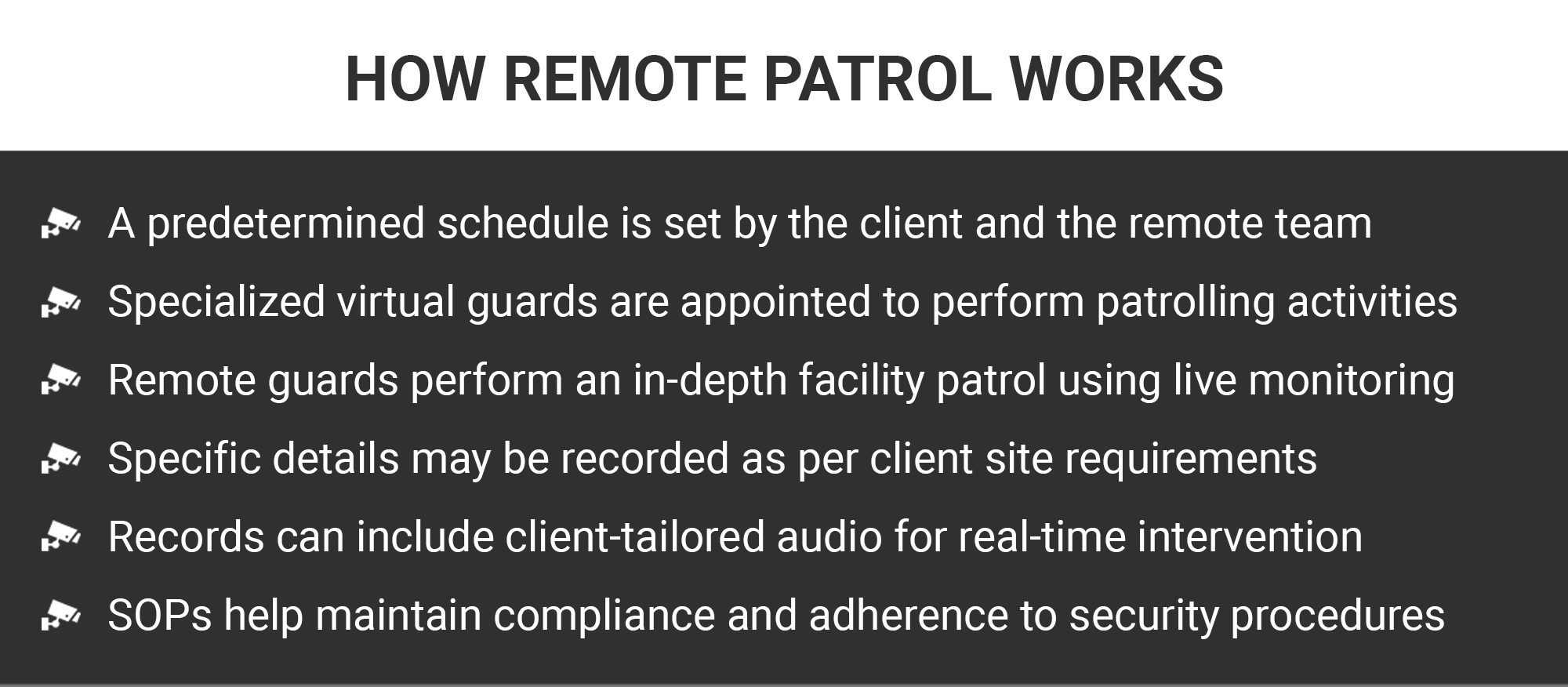
Advantages of remote patrol
- Pre-inspection provides a macro view and compliance with company policies.
- Reduces cases of theft and vandalism as most will not risk being caught and charged.
- On-ground officers can focus on important duties that require local presence.
Video surveillance
CCTV surveillance is conducted using motion-detecting cameras connected to a 24-hour remote monitoring control center. High-speed broadband, wireless connections, integrated cameras and motion sensors in surveillance cameras can help virtual guards detect any suspicious activity on site.
Video surveillance is an effective solution for a variety of sites ranging from campus security, warehouse, construction sites, retail stores, shopping malls, parking lots, healthcare premises. The way CCTV surveillance works is that the virtual guards monitor live video footage, allowing installed cameras to detect and highlight any kind of movement. A member of the surveillance team can determine if the movement is a real threat or a nuisance alarm such as a local neighborhood cat setting off the sensors. If live footage detects human movement, a remote guard warns the intruder that his actions are being recorded and law enforcement bodies will be notified. For decades, analog video surveillance has been the standard of safety in various industries. Today, technology and software have come a long way, making it an excellent time for security agencies and other businesses to upgrade to digital video surveillance.
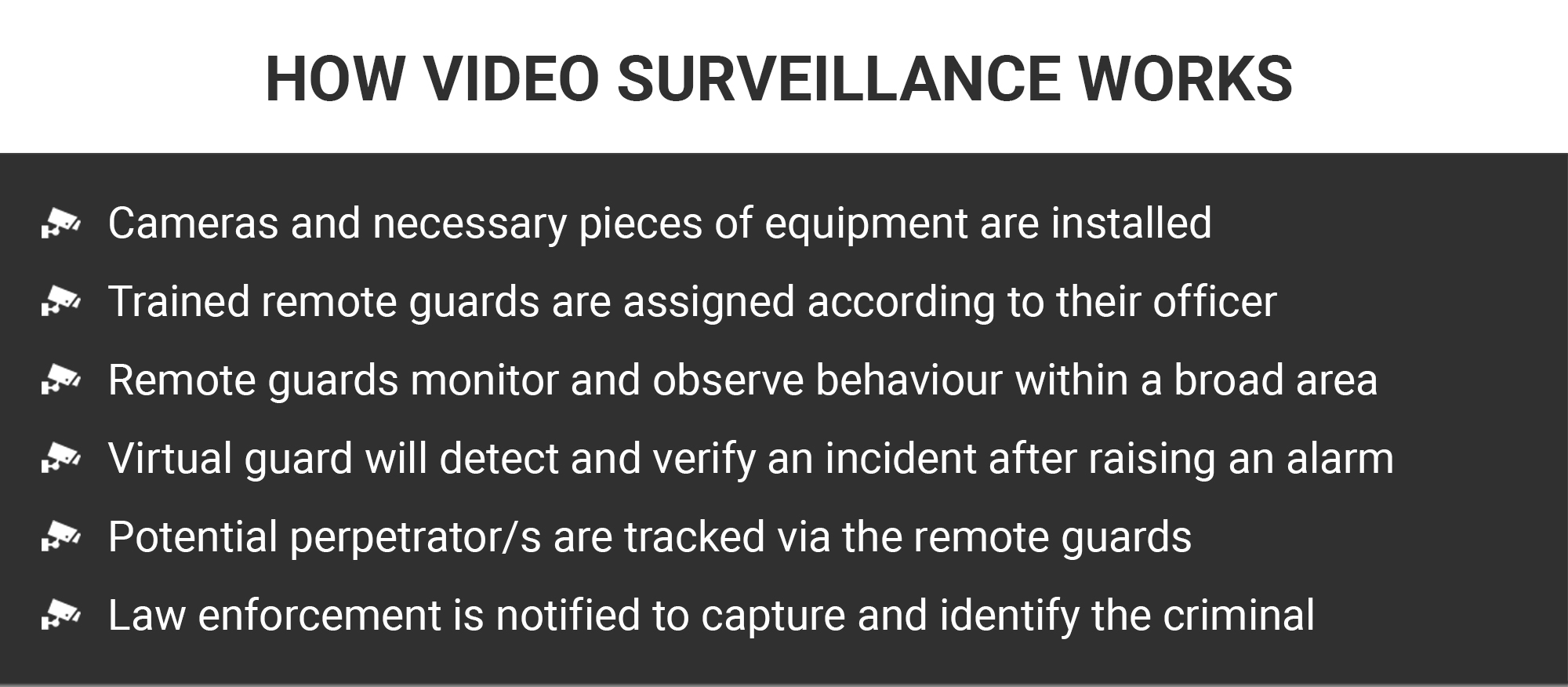
Advantages of video surveillance
- Offers high-definition and wider viewing angles with clarity.
- Provides the flexibility of secure, remote login allowing multiple digital feeds.
- Monitor activity on your surveillance feeds from anywhere in the world.
Intervene
In the instance that surveillance cameras end up detecting suspicious behavior, remote security guards will actually reach out to the suspicious individual with help of an audio system for voice-down intervention. The potential perpetrator is notified that they are being monitored and that local enforcement will be dispatched in case a crime occurs. In many cases, the individual will leave immediately. The event is recorded by a CCTV camera and a video clip of the incident can be provided to the customer and/or authorities depending on the security agency’s standard operating protocol.
Alarm monitoring
In addition to deterring criminal activity, raising fire or disaster alerts, protecting property & valuables; alarm monitoring services give security services agencies the ability to investigate on-site alarm activations immediately. Upon notification of a triggered alarm, remote guarding officers at the remote center retrieve footage from site cameras to triage the situation and determine if the situation is an emergency, a potential threat or a false alarm. In cases where there is a crime in progress, remote guarding officers can provide critical real-time updates as the situation unfolds.
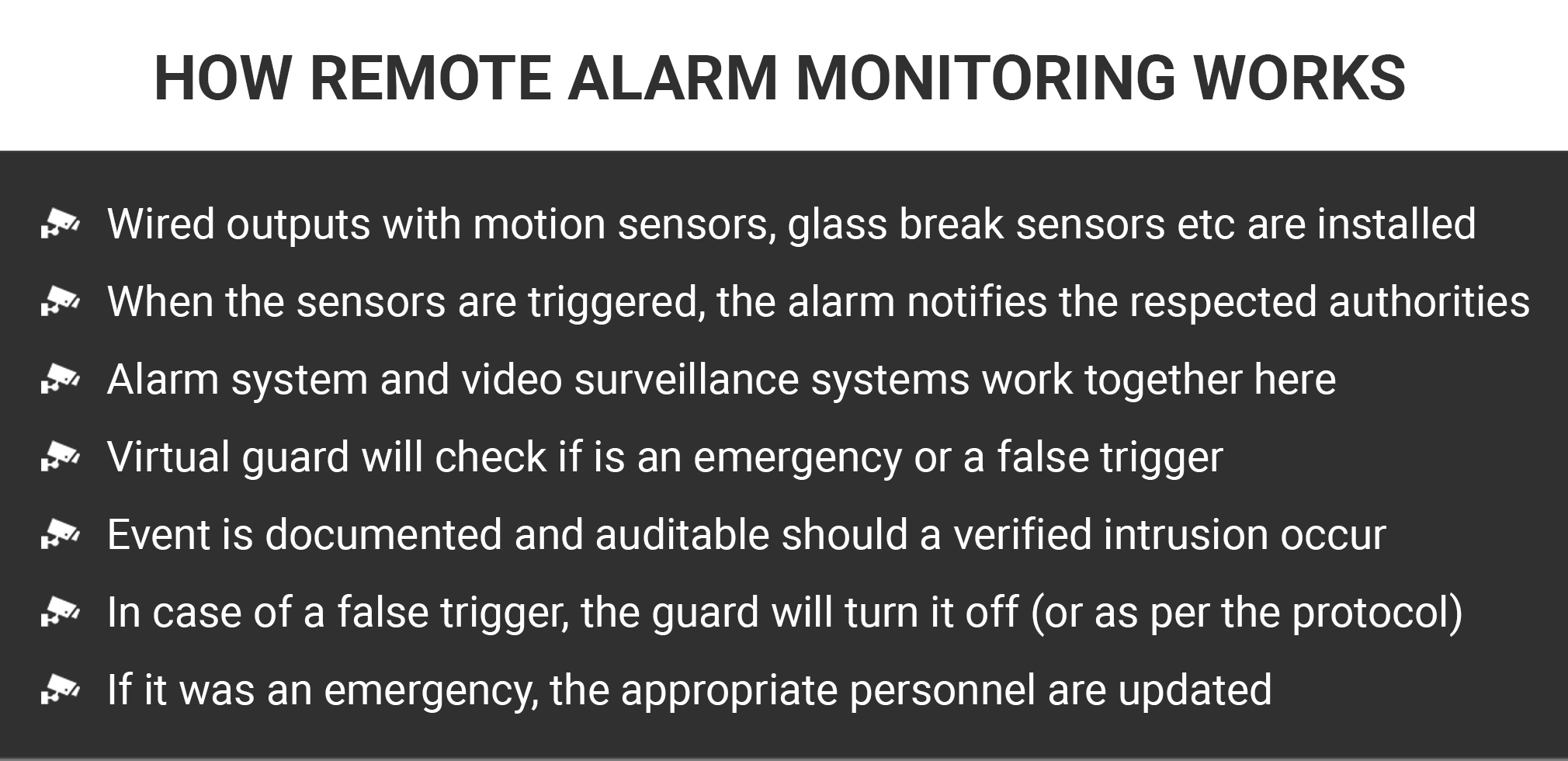
Advantages of remote alarm monitoring
- Rapid response to real-time crimes occurring in the client perimeter
- Reduce response time for emergency services and verified alarm response
- Ensure safety by raising alarms for threats without being physically present
Gatehouse Access
Gatehouse surveillance prevents any unauthorized personnel from entering client premises. This helps lower the risks of petty crimes like vandalism and theft. A remote doorman or gatehouse surveillance guard helps security agencies maintain control over access to entry and exit areas. Retirement communities, medical laboratories, schools and parking lots are great candidates for gatehouse access monitoring. A remote doorman activates cameras and audio devices, scans the area and follows your established authorization protocol to prevent unauthorized visitors from accessing areas closed to public access.
Gatehouse surveillance personnel help manage remote entry and exit by working with remote security officers to verify that entry points are open only for authorized persons. Based on the security agency’s access control protocols, remote guards can perform functions ranging from verifying the identity of persons requesting access, confirming authentication, monitoring and recording activity as well as reporting exceptions.
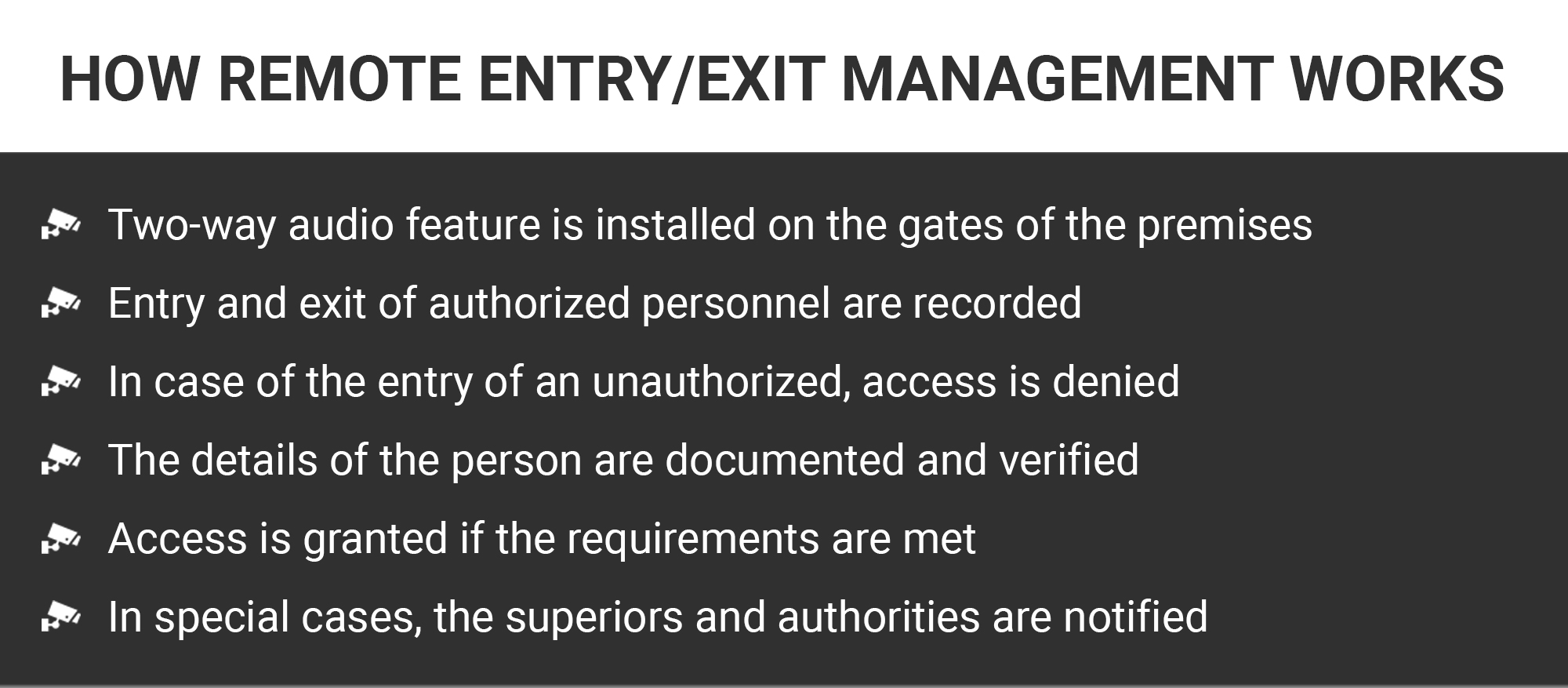
Advantages of remote entry/exit management
- Provide on-demand processing of individuals requesting access to facility
- Maintain and document employees, visitors and contractors as they enter or leave
- Handle each request uniformly & create meaningful data to track personnel activity
Diffuse volatile situations
Sometimes, potential perpetrators may think that the cameras are faux just to prevent them from doing the act of misconduct. When intervening and restricting them doesn’t help, the remote guards are forced to diffuse the situations by stepping in. The perpetrators are warned that they are being watched. These warnings are not general pre-recorded messages but live-specific for the criminal. For example, instead of saying like a robot, “Warning, you are being watched.” this is what is used, “Hey, the guy in the blue shirt who jumped over the fence, you are being watched. The authorities have been informed.”
Voice down
Remote voice-down systems allow agents to ‘intervene’ more actively with this feature. When illegal or unsuitable activities occur, the voice-down feature can help guards to step in and prevents these activities before matters get too late. The remote guards use the audio feature and talk directly to the offender. A personalized conversation can spook suspicious individuals into abandoning their activity and leaving immediately. Since voice-down can be implemented in real-time, the virtual security guards can hear what is going on at the other end as it happens. This makes it easier for remote guards to respond to problems or emergencies immediately.
Depending on the protocols adopted, the remote guard can inform local authorities, effectively circumventing unnecessary red-tape to ensure swift resolution and crime prevention. With the power of virtual guards, the instances of law enforcement professionals having to visit a site for petty activities that can be easily prevented also goes down. So, instead of attending to every alarm, they now only have to respond to active, verified breach reports of incidents-in-progress. The remote guard can actually guide police or armed on-site guards to the exact location of a crime in progress – ensuring greater safety for all as that no one is walking into a dangerous situation blind.
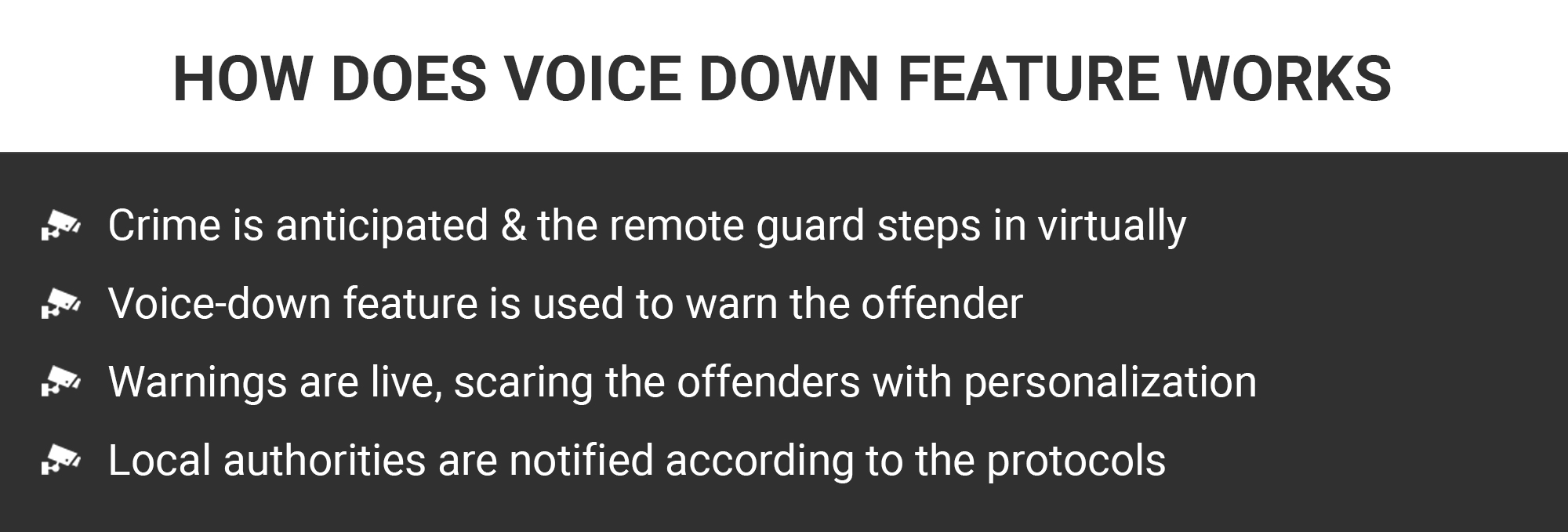
Advantages of voice down
- No time and resources are wasted on false alarms
- Majority of perpetrators get scared of the message conveyed by a live guard personally
- Law enforcement are deployed when the crime is in progress
What about investigations?
So, despite all of the perimeter safety measures, voice down protocols and escalation channels put in place, a perpetrator still manages to commit a crime. Now what?
In the event that a crime occurs, a remote guarding team will have Measures in place to help assist with investigations. The first thing you want to do when a crime occurs is to sit down and figure out where the Vulnerability lies that the criminal had leveraged to commit the crime. Creating a safe space around discussions on how we can improve security services allows for transparent, productive conversations where all sorts of blind spots can be discussed. Such due diligence results in watertight security solutions and continuous process improvement. Of course, since we are talking about the electronic security industry, investigating teams will have quick access to footage and video analytics. This includes everything from video verification, license plate capture cameras to two-way audio warning systems.
Concerned about various sites?
Educational Campus Security
Remote guards need not be extensively trained. We found work by Every Town Research that noted the following statistics. Every year, more than 3,000 children & teens are killed and 15,000 more are injured due to gunfire. Campuses need 24×7 patrolling – especially at night – to ensure safety to the students, staff and the campus property. Most rule-breakers tend to vandalize school property just for the fun of it. With the use of virtual patrolling techniques described earlier, remote guards can enhance student and faculty safety as well as reduce crime rates on campus.
In case of a crime being detected on campus grounds, virtual guards can immediately trigger an alarm and notify the concerned authorities. If the offenders refuse to stop their activities, voice-down technology is often used to let them know they are being watched and in case of continued disobedience, law enforcement will be notified. This warning has helped scare off many instances of vandalism, petty theft and even assault at campuses across the nation.
Healthcare Facility Security
Patients, visitors and staff walk in and out of the medical campuses or hospitals all day long. Unfortunately, child abductions in hospitals are a common occurrence, especially at facilities that are short-staffed. Patrolling and continuous supervision done by security officers will bar their efforts and provide additional security for not only children but also patients and staff. Remote patrolling is efficient in keeping a check and anticipating a crime by closely monitoring the actions of possible criminals.
Healthcare premises are often equipped with strong surveillance systems to ensure the safety of their vulnerable clientele. Hiring remote security officers can help you for your hospital clients can help address threats immediately. Remote patrolling of hospital premises will keep an eye out for potential threats while simultaneously recording the activities of people. Any suspicious activity can be addressed immediately before matters worsen.
Finally, according to the National Institute for Occupational Safety and Health (NIOSH), health and social service workers face a significant risk of work-related violence. The presence of a security camera prevents potential perpetrators from engaging in unlawful activities and if they do not stop, the recordings can be used against them.
Warehouse Facility Security
Full-perimeter surveillance helps monitor warehouses for break-ins, inventory theft, assault on warehouse workers and vandalism. Many of the newer security cameras have a night vision feature allowing them to keep the warehouse safe even in poorly lit areas where physical guards can’t see clearly. Due to the motion sensors in cameras and the alertness of the remote guards, the perpetrators can be easily stopped before they commit the crime.
While dealing with the security of the warehouses during a global pandemic, there is a need to ensure to detect any on-going crime. This detection may get tough if there are multiple locations to look after via video surveillance. To safeguard the warehouse, a remote electronic security team will assist in overcoming problems by anticipating, intervening and diffusing situations by performing the following functions.
- Monitoring entry & exit
- Tracking unknown vehicles
- Catching inventory theft
- Centralized approach to monitoring every client site
- Ensure perimeter security
When it comes to warehouse security, there is one additional consideration. Often, designated areas are open at only certain times, when clients dispatch or receive deliveries. This is a particular security concern outside of office hours. In these circumstances, virtual guards also offer the additional support needed to remotely lock and unlock designated areas to ensure security across the entire site using gatehouse surveillance.
Prevent crimes with an extra set of eyes
When virtual guards conduct live monitoring at a particular client site, they are trained to cover the entire perimeter via virtual patrol, video and alarm monitoring, gatehouse surveillance, voice-down and video analytics.
Virtual guards use the above operational functions to keep an eye on any suspicious activity so that they can warn relevant authorities in case they anticipate a crime in action. Virtual guards are also trained to use voice-down features to warn intruders of further consequences in case the intruder follows through with illegal action. Research shows that these voice-down warnings reduce future chances of a crime being committed on a particular client site.
Here is a classic example of our continuous process improvement. A month ago, one of our security agency clients came up to us with a classic parking lot security issue. One corner of the parking lot was poorly lit with easy access to the public road.
With the help of CCTVs, our remote guards were already surveilling the parking area when a virtual guard noticed a man jumping off the fence. As he was walking with a beanie covering his face towards one of the vehicles, a remote security guard used the audio feature and said, “The man with the red bag and a beanie, you are being watched. I suggest leaving the premises immediately. The authorities have been informed.” The suspicious person was visibly startled and seen walking away from the premises almost immediately.
Remote patrolling also provides an active security presence with a bird’s eye view of vulnerable areas of a particular facility. Video-based patrols provide additional support to local security teams. Patrols can be tailored to specific needs by reviewing and recording essential details, issuing the necessary notices and increasing the intensity of intervention over time if needed.
While we cannot predict when a criminal will commit a crime, we can take diligence measures to ensure there are detailed protocols in place in case something does go wrong. As with any other business, there is constant evolution in operational procedure when it comes to improving security services. Remote guarding is no different!
We know that crimes such as burglary, vandalism, assault and theft cause not only monetary loss but also loss of mental peace and reputation. For security agencies looking to expand their capacity to onboard more clients by delegating the mundane functions, Technomine offers solutions ranging from CCTV monitoring, virtual patrolling, panic response, footage retrieval & analytics, access control management, truck yard monitoring, security, intruder, fire & burglar alarm monitoring to gatehouse & access control.
